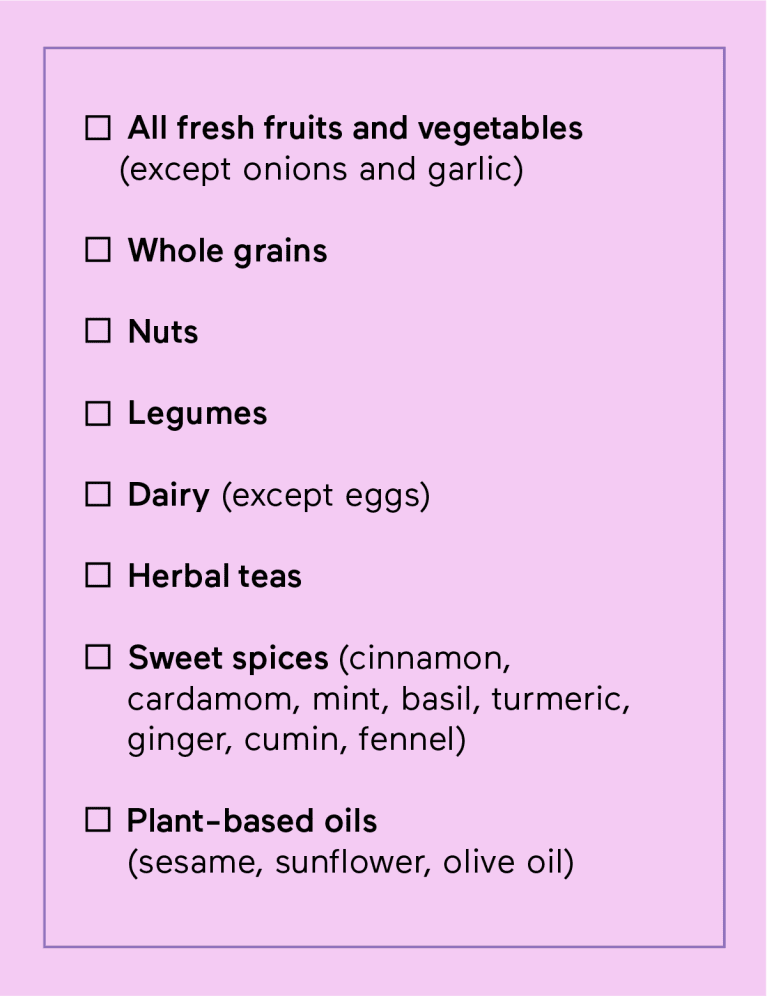The yogic diet is based on the yoga principles of purity (sattvic), nonviolence (ahimsa), and balanced living. It consists of foods with sattvic qualities, which increase energy and create balance in the mind and body.
Yoga class may give you the toned triceps and strong core you’ve always wanted—but as always, optimal health is just as much about what’s on the inside.
Enter the yogic diet, an ancient way of eating that focuses on whole foods, mindful eating, and nourishing your body. If you’re interested in taking the principles of yoga off the mat and into the kitchen, , here’s everything you need to know to get started.
What is the yogic diet?
the yogic diet recommends eating whole, unprocessed foods, like fresh fruits and vegetables. These foods—which are nutritious and easy to digest—are known as Sattvic (pure) foods. The opposite of that are Tamasic (angry) Rajasic (forceful foods), like meat and alcohol, which are prohibited on the yogic diet.
Also known as the sattvic diet, the yogic diet is based on the belief that our bodies are directly connected to our minds. Consider it the literal version of “you are what you eat”—so if you eat sattvic foods, both your mind and body will be pure.
What are the health benefits?
Following a plant-based, whole-food diet is foundational for nourishing all systems of the body. Below are some of the top benefits of switching to the yogic diet for both your physical and mental health.
1. Improves digestion.
Studies support that plant-based vegetarian (and vegan) styles of eating promote healthier gut microbiomes. It makes total sense, as the more fruits, veggies, and whole grains you eat, the more fiber you consume—which we know feeds your gut flora and encourages regular bowel movements.
2. Boosts your metabolism.
Optimizing metabolism will result in improvements in both energy and digestion. Scientists have shown that plant-eaters on average have a higher resting metabolic rate than meat-eaters, which means they are burning more calories throughout the day, even at rest.
3. Increases your energy.
Foods like nuts, whole grains, and legumes have a low glycemic index (GI) which means they’re digested more slowly, providing your body with a steady stream of energy. These whole foods are also nutrient-dense, fueling your cells with the micronutrients they need to function properly.
4. Reduces risk of chronic diseases.
Multiple studies have found that people who follow a vegetarian diet are up to 22 percent less likely to have coronary heart disease than meat-eaters. Due to high intakes of plant-based, antioxidant-rich foods, research has also shown that vegetarians have a lower risk of diabetes, cancer, and other chronic health conditions.
5. Improves your mood.
Research continues to explore the powerful gut-brain connection, which supports the premise that what you eat impacts emotion. One systematic review revealed that people who increased their intake of plant-based foods (such as fruits, vegetables, and whole grains) had a reduced risk of depression, whereas another study found that diets high in processed foods were associated with higher risk of depression.
How to follow the yogic diet?
To make the switch to the yogic diet, start by planning meals and snacks that include a balance of protein, carbs, and fats. You can do this by choosing different fresh fruits and veggies, nuts, legumes, dairy, and whole grains (all of which are “approved” on the yogic diet). The exceptions are onions and garlic, which are thought to increase heat in the body.
While not necessary, the yogic diet strongly recommends opting for organic, non-GMO foods, as well. The less processed the food, the more “pure” (or sattvic) it is, which yogis believe affects how your body and mind react to it.
The yogic diet has guidelines for drinks, too. Cut out (or cut back on) alcohol and caffeine, which over-stimulate your body, and drink more water or herbal tea instead.
Most importantly, it’s not just about what you eat, either—it’s also how you eat. The yogic diet encourages mindful eating, whether it’s slowing down to really chew and savor your food or eliminating distractions while you eat so you’re 100 percent present.
Encouraged foods:
Below is a list of the approved foods on the yogic diet. Keep in mind that while the diet emphasizes all fruits and veggies, it’s best to steer clear of onions and garlic!

AVOID –

DR.RITA BEHAL
FOUNDER OF AYURVEDA AVATARAN
HOLISTIC NUTRITION ACADEMY
AYURVEDIC PRACTITIONER
SR. DIET AND LIFESTYLE CONSULTANT
AUTHOR OF AYURVEDIC BOOK ON VEDIQUE DIET
(HOLISTIC APPROACH TO HEALTH)
EMAIL ID-INFO.AYURVEDAAVATARAN.COM
WHATSAPP NO-+91,6239412606,+91,9888044698